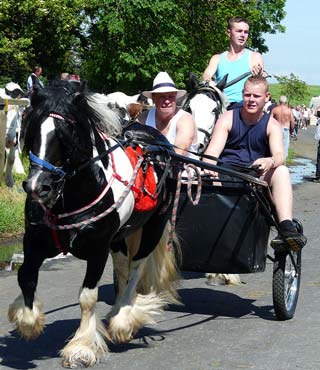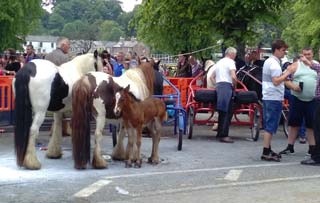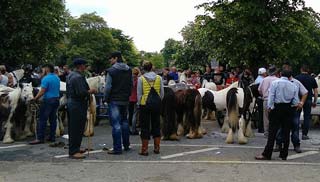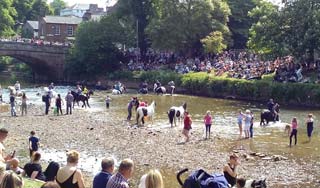16 Jan 2017
Understanding Appleby Horse Fair
Suzanne Rogers reports on the results and feedback from a questionnaire with owners at the annual event held in Cumbria.

Horses being washed and given the opportunity to drink in the river.
Every June, thousands of people gather in Appleby, a small town in Cumbria, for one of the biggest events on the gypsy and traveller calendar – the Appleby Horse Fair.

During the fair, horses are traded, with some changing hands numerous times during the course of the week-long event. Horses are shown off in various places – they are ridden or driven up and down the “flashing lane”, and tethered at various locations. They are also taken to the river to cool off – this tradition is featured in many iconic photographs of the fair and is a particular spectacle for tourists. Each year sees a growing number of stalls selling clothes, equipment for horses and a huge range of souvenirs.
Welfare concerns exist for animals traded during the event, although, over the years, significant improvements have been made, thanks largely to the increasingly coordinated effort by members of the National Equine Welfare Council (NEWC). For example, the entry point to the river used to be responsible for a high number of injuries before a ramp was introduced, and the number of dogs and caged birds traded has also significantly decreased.
The remaining welfare concerns are mostly related to riding and driving practices, including young horses being driven prior to maturity, on the flashing lane, inappropriate harnessing and farriery, and overwork – especially in hot weather.
Engaging through interviews
At the 2016 fair, the Community Horse and Pony Scheme (CHAPS), based in Swansea, interviewed 100 attendees with the aim of achieving a better understanding of how horse trading and urban horse ownership in Swansea compares with the gypsy and traveller community across the UK.
It also wanted to gain information about the trends in the horse trade, such as fashion preference, to place CHAPS’ experiences in Swansea in context and to better understand the societal issues the horse trading and traveller communities face. The interviews were conducted in an interactive manner.
It found 97% of interviewees had kept horses their whole lives and 99% came from horse-trading families – highlighting the importance of family tradition and culture. This point cannot be highlighted strongly enough, as the personal and social identity of these people is rooted in horse ownership and to encourage them to give it up, or to change their practices without truly understanding why they should do so, is unlikely to be successful.
CHAPS wanted to find out how the traders interviewed kept their horses – 84% keep their horses in a field for some or all of the time, 60% in a stable for at least some of the time and 62% tether for at least some of the time. Whether good practice is being followed for each management method was not asked. Only 33% use all three methods and overlaps exist between combinations of two methods of management – 11% kept their horses exclusively tethered, 14% exclusively in fields and none were exclusively kept in stables.
The interviewers would be interested to compare this with the wider horse-owning communities, as, in the author’s experience, many leisure horses are kept exclusively stabled with no opportunity for turnout.
When asked “do you think horses should be kept in fields, stables, tethered or a combination?”, 73% answered fields, 5% tethered, 10% field and stable, 4% field and tethered, and 8% all three methods depending on the situation. This reflects a prevalent understanding that horses’ welfare needs can best be met by partial or 24/7 turnout.
Role of vets in engagement
In response to the question “if you need help with your horse, who do you contact?”, 72% of those interviewed would contact vets, 15% family and 11% “other”, such as the internet. This question was ambiguous on purpose and did not qualify by saying “in an emergency” – the interviewers wanted a “knee-jerk” reaction regarding their primary source of information for horse issues.
The high percentage of people who answered vet was encouraging and conversation points with interviewees highlighted that many horse traders used family vets who had been working with their families for a long time. Some people said their vet gave them “special treatment” – in particular, leniency with regards to passports – and expressed concern their vet was due to retire imminently. This highlights the need for continued communication and outreach by vets to maintain trust and long-standing relationships with the gypsy and traveller communities.
The percentage of interviewees whose primary source of help was the internet was surprisingly low, especially given the number of interviewees who were in their early 20s. This would be interesting to explore further because some planned interventions and communication platforms rely on internet use.
Many interviewees said they would not approach charities for advice and some said they would not need advice unless a vet was required. This highlights the role of vets in welfare programmes aiming to engage with these horse-owning communities.
Key messages

The team partly focused on overwork and dehydration for the 2016 fair, so we asked owners “how much water does a horse need in a day?” Many people (20%) correctly said it depended on many things and some listed factors to consider, such as weather, workload and lactation.
A relatively high percentage (27%) did not know the answer, even to guess. The majority of people who guessed were in the correct range, but 14% guessed significantly less than a horse really needs. However, knowledge does not necessarily translate into management. It would be interesting to compare results with those from the leisure horse sector.
Horse traders were asked what age they started working horses. In total, 5% of interviewees start working with the horse in some way from just after birth – this could be concerning, but could just mean touching the horse to get him or her used to humans rather than any formal training. The high percentage of horses starting at one and two years of age is much too young because the skeleton and associated musculature is developing. Only 8% of horses were started at three years old, but a horse’s skeleton did not fuse until five to seven years of age.
These responses were somewhat backed up by observations at the fair – many young foals were present, mostly at foot, and some very young animals were being ridden or driven on the flashing lane.
Many owners and traders expressed disapproval at the treatment of the horses on the flashing lane, feeling they were being worked too hard, too fast and too young. This provided the opportunity to let owners listen to a horse’s heart rate with a stethoscope. This was a popular method of engagement and could be incorporated into discussions between vets and horse owners to help understanding and recognition of overwork.
The subset of people working their horses in this manner is not representative of the welfare standards across the gypsy and traveller community and it is important this is recognised by those working with it.
It was found people were not able to recognise the signs of fear in the horse, as was highlighted as one of the key welfare challenges by a World Horse Welfare and University of Bristol report1. This issue is widespread across equestrian culture and needs to be addressed nationwide.
Thirst for education

Interviewees were asked what topics they would most like to learn about horse ownership. CHAPS provides a range of educational opportunities for urban horse owners and the wider equestrian community, with a focus on opportunities for children excluded from mainstream education and adults suffering from post-traumatic stress disorder. It can be seen that general care and management, followed by farriery, were the most popular topics and youngsters/training, breeding and “everything” were all given equal importance.
Interviewees were generally very interested in the services CHAPS provides or plans to provide – a community riding school, grazing project, educational opportunities and qualifications, and outreach community events – for themselves or their children, or expressed regret something similar did not exist years ago.
This article has covered just a few of the questions asked – the full report can be found online2. The research will help to plan engagement with the rest of the NEWC education team for the fair in 2017 and some findings will be useful in year-round work in progress by the organisations involved.
Latest news

Livestock
Rising paromomycin resistance forces rethink in calf scours management
Sponsored
21 May 2025

